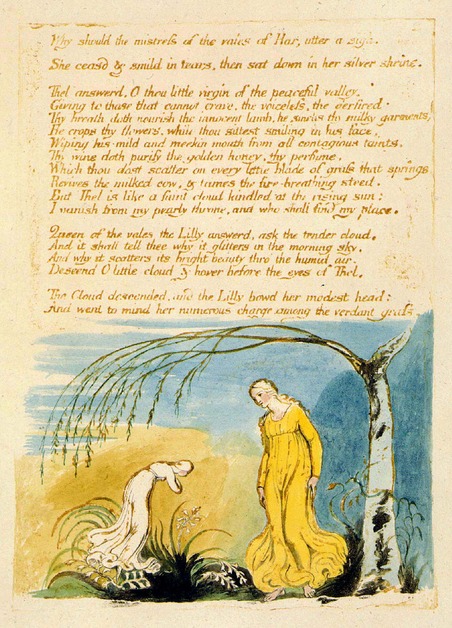Thel, one of the Immortals (in the vales of Har) is attracted to the life below (as we all were). After hearing the encouragement of the Lilly of the valley, the little cloud, the helpless worm, and the clod of clay she ventures down: Book of Thel, Plate 6, (E 6) "The eternal gates terrific porter lifted the northern bar: Thel enter'd in & saw the secrets of the land unknown; She saw the couches of the dead,..... The Virgin started from her seat, & with a shriek. Fled back unhinderd till she came into the vales of Har"
This poem may also be considered a commentary on Innocence and Experience: the vales of Har represent Innocence while the northern bar leads to Experience. Descent from Eden leads to Experience, and when fully experienced, one may return to his (eternal) origin. Thel chose not to go through that journey, so it doesn't express Blake's myth except to act as a preamble. Cave of the NymphsThree things stand out prominently in this wonderful picture: On the right is the cave of the nymphs who conduct innocent souls by the northern gate down into mortal life. Below the cave spread across the bottom is the Sea of Time and Space. On the upper left you see a representation of the Heavenly Realm. Homer wrote about the Cave of the Nymphs in the 13th Book of the Odyssey:
Blake loved the looms and used them repeatedly in his prophecies; in his larger prophecies he described the "nymphs" as vicious wicked women; in fact there are pages of these wicked women. (The feminine of course connotes the earthly (under the moon), and the masculine heavenly (under the sun) - As offensive as this may be to many readers, I don't know any help for it. It might be considered the guideline that men used in their subjugation of women. Blake wasn't responsible; he adopted all the ancient symbols, including this one.) Blake's picture portrays the two realms, connected by two passages, sometimes called gates or bars or stairs. The picture shows them as stairs. The prominent gate on the right, called the northern bar, is especially rich in symbols that Blake used over and over as he wrote, etched, drew and painted. Immediately to the left of the northern gate is the southern gate of 'return' where worthy mortals ascend into the higher realm of immortality. In the upper part of the picture the nymphs prepare souls for the descent into the "sea of time and space". The northern gate is filled with a stream, the current moving downward into the sea. Blake shows two souls scheduled for mortal life; each possesses a tub or pail which the nymphs prepared for them containing spiritual truth and power for the hazardous journey into the world. At the bottom of the cave one of these 'women' lies in the water blissfully asleep; her tub is turned on its side, all the spiritual things spilled and replaced by the water of mortal life. The other woman has carefully protected her pail and against the opposition of the nymphs turned decisively back toward the higher realm; following Heraclitus she may be said to be a dry soul. (This scene evokes Jesus' story of the wise and foolish virgins. The dry soul also suggests Thel, who crossed the northern bar, but drew back in horror at the miry clay ahead. The two imaginary humans represent the choices that each of us make every moment: to go the heavenly way or the worldly way, the two ways that that Jesus spoke of in Matthew 7:13-14.) In the symbolic language water denotes matter, the inferior, the worldly. Souls in the higher realm are attracted by the moisture. 'Time and space' is a sea where mortal creatures suffer adventures that may be creative or destructive. Similar and closely related to dry and moist souls are those awake and those sleeping (this runs like a current throughout the Bible and through Blake as well.) The Sea of Time and Space
Behind Odysseus stands his protector goddess, Athena pointing him to the courts above. (The return of Odysseus to his home closely parallels Elijah's ascent on the fiery chariot into Heaven, and of course the Ascension of Our Lord. The thing to remember is that rather than material events these are metaphors. Our metaphors are spacious and temporal; not so in Eternity.) The upper left of the picture shows God upon a chariot, driven by the Four Zoas and surrounded by the immortals. God appears to be a right sleepy god; the import is that it's the inner God who goes to sleep when the soul finds the couch of death and awakens to mortal life (Blake and Antiquity page 15). Raine quotes: "05 My Eternal Man set in Repose 06 The Female from his darkness rose" The Gates of Paradise, (E 386) For more detail look at these posts. Once you've grasped the whole of this story you may notice how closely it parallels the primary Bible myth of Creation, Fall and eventual Redemption. It's the old, old story, and in the end there's only one story. (Jesus gave us an abbreviated version of it with The Prodigal Son.) |
Here you may meet William Blake, join hands in a discussion, ask questions. This is your Blake Commentary.
Monday, April 09, 2018
Myths 1
Subscribe to:
Post Comments (Atom)


1 comment:
Very informative and impressive post you have written, this is quite interesting and i have went through it completely, an upgraded information is shared, keep sharing such valuable information. Sleeping podcast
Post a Comment